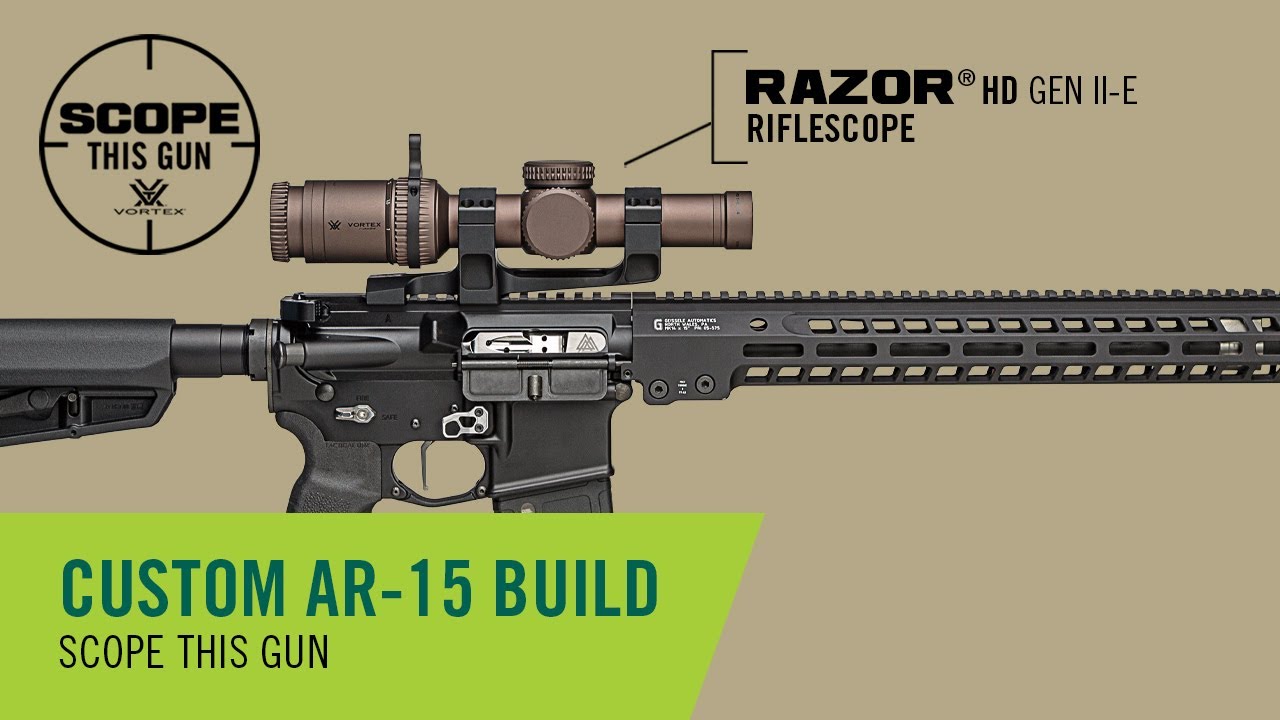How to Choose the Right Optics for Your Custom AR-15 Build
Choosing the right optics for your custom AR-15 build can greatly enhance your shooting accuracy and overall experience. Whether you’re aiming for long-range precision or quick target acquisition, the right optics can make all the difference.
Understanding the Basics of AR-15 Optics
Selecting the appropriate optics for your AR-15 is crucial as it can significantly impact your shooting effectiveness. With a wide range of options available in the market, understanding the basics helps streamline the selection process. There are multiple types of optics designed for various shooting applications, each offering unique benefits.
The Importance of Choosing the Right Optics
Investing in high-quality optics ensures you’re getting reliable performance, especially in critical situations. Optics not only enhance your aiming precision but also allow you to shoot accurately over longer distances. Optics are indispensable for achieving consistent results, whether you’re involved in tactical shooting or hunting.
Common Types of Optics for AR-15
The market offers numerous optics options including rifle scopes, red dot sights, holographic sights, and magnifiers. Each type caters to specific shooting needs and environments. Understanding the differences and benefits of each type can guide you in making an informed decision.
Types of Optics
Rifle Scopes
Rifle scopes are essential for long-range shooting. They come in various magnifications, allowing shooters to engage targets at extended distances. Variable power scopes offer adjustable magnification levels whereas fixed power scopes have a single set magnification.
Long-Range Accuracy Rifle scopes are specifically designed to enhance accuracy over long distances. They allow shooters to view targets clearly and make precise adjustments for windage and elevation.
Variable and Fixed Power Variable power scopes offer flexibility by providing adjustable magnification. This adaptability is crucial for shooters engaging in varying target distances. Fixed power scopes, on the other hand, offer simplicity with no need for adjustment, making them reliable under fixed conditions.
Red Dot Sights
Red dot sights are popular for their ability to provide rapid target acquisition. They are an excellent choice for close-quarters and fast-paced shooting scenarios.
Quick Target Acquisition Red dot sights allow shooters to quickly align their aim with the target, which is beneficial in high-speed shooting situations. The simplicity of aiming with a red dot makes it ideal for both new and experienced shooters.
Battery Life and Durability Modern red dot sights offer extended battery life and durable construction, ensuring they withstand harsh environments. Features such as shockproof and waterproof designs enhance their reliability.
Holographic Sights
Holographic sights use advanced technology to project a reticle onto a lens. They offer a clear sight picture that remains aligned regardless of the shooter’s eye position.
Reticle Types and Sight Picture Holographic sights often feature customizable reticles, which can be adjusted for different shooting conditions. The sight picture is usually clearer and more consistent compared to red dot sights.
Comparisons with Red Dot Sights While red dot sights are simpler and more affordable, holographic sights provide better precision and feature-set, making them suitable for more demanding shooting tasks.
Magnifiers
Magnifiers are supplementary optics that can be mounted behind red dot or holographic sights to increase magnification when needed.
Increasing Sight Range Magnifiers enable shooters to extend their effective range without switching to a different optic. They are particularly useful for transitioning between short and long-range targets quickly.
Compatibility with Existing Optics Magnifiers are designed to work seamlessly with existing optics, ensuring a versatile shooting setup. Many models feature flip-to-side mounts, allowing them to be used or stowed away as needed.
Key Features to Consider
Reticle Types
The reticle is the aiming point within the optic, and choosing the right type can impact accuracy and functionality.
Mil-Dot vs. BDC Reticles Mil-Dot reticles are known for their precision and are commonly used in tactical applications. BDC (Bullet Drop Compensation) reticles are designed to account for bullet drop over long distances, making them ideal for long-range shooting.
Illuminated Reticles Illuminated reticles enhance visibility in low-light conditions. They are essential for scenarios where lighting may affect target acquisition and accuracy.
Eye Relief and Parallax
Proper eye relief and parallax settings are crucial for comfortable and accurate shooting.
Importance for User Comfort Eye relief refers to the distance between the shooter’s eye and the optic. Adequate eye relief prevents scope bite and ensures comfortable viewing.
Adjusting Parallax Settings Parallax adjustments help in aligning the reticle with the target image, eliminating any shifts due to head movement. This is essential for maintaining accuracy at various distances.
Field of View and Magnification
Assessing Field of View
The field of view (FOV) is the visible area through the optic. A wider FOV is beneficial for tracking moving targets and situational awareness.
Choosing the Right Magnification
Selecting the right magnification depends on the shooting application. Higher magnification is ideal for long-range precision, while lower magnification suits close-quarters engagements.
Optics Specifications and Terms
Understanding Lens Coatings
Lens coatings enhance light transmission and reduce glare. Fully multi-coated lenses offer the best clarity and performance in various lighting conditions.
Importance of Waterproof and Fogproof Features Waterproof and fogproof optics ensure reliability in adverse weather conditions. These features protect the internal components from moisture and temperature fluctuations.
Turrets and Adjustment Knobs Turrets are used to adjust windage and elevation settings. High-quality turrets offer precise, tactile adjustments, critical for long-range accuracy.
Budget Considerations
Balancing Cost and Performance
While higher-end optics offer superior performance, many budget-friendly options provide excellent functionality. Balancing cost and performance ensures you get the best value without compromising on quality.
Recommended Budget-Friendly Options
Brands like Vortex Optics, Primary Arms, and Bushnell offer cost-effective models known for durability and performance. Evaluating features within your budget can lead to a satisfying purchase.
Popular Brands and Models
Trijicon
Trijicon offers high-quality optics known for their durability and performance. Their ACOG series is popular among military and law enforcement personnel.
Vortex Optics
Vortex Optics provides a range of optics suitable for various applications. They are known for their excellent warranty and customer support.
EOTech
EOTech holographic sights are favored for their clear reticles and rugged construction. They are commonly used in tactical environments.
Aimpoint
Aimpoint red dot sights are trusted by professional shooters for their reliability and long battery life. They offer a range of models suited for different needs.
Other Notable Brands
Leupold, Holosun, Sig Sauer, and Nikon also offer high-quality optics. Each brand has unique features and specialties catering to different shooting preferences.
Mounting and Compatibility
Understanding Picatinny vs. Weaver Rails
Picatinny and Weaver rails are common mounting systems. Picatinny rails offer more slots for mounting flexibility, while Weaver rails are simpler and lighter.
Co-Witnessing with Iron Sights
Co-witnessing involves aligning your optics with iron sights. This setup ensures you have a backup aiming method if your primary optic fails.
Mounting Options and Considerations
Choosing the right mount is crucial for maintaining optic stability and alignment. Quick-detach mounts offer convenience for switching between optics.
Use Case Scenarios
Tactical Shooting
For tactical applications, optics like holographic and red dot sights provide rapid target acquisition and durability.
Hunting
Hunting requires optics with good low-light performance and reticles designed for long-range accuracy. Variable power scopes are ideal for hunting scenarios.
Competitive Shooting
Competitive shooting demands optics that offer precision and quick adjustments. Red dot sights and low-power variable scopes are popular choices.
Maintenance and Care for Optics
Cleaning Lens Properly
Regularly clean the lenses using microfiber cloths and appropriate cleaning solutions to maintain clarity and prevent scratches.
Storing Optics to Avoid Damage
Proper storage in padded cases protects optics from physical damage and environmental factors. Keeping them dry and clean ensures longevity.
Best Practices and Final Tips
Zeroing Your Scope
Zeroing ensures your point of aim matches the point of impact. Regularly zero your scope to maintain accuracy.
Regularly Checking for Sight Alignment
During usage, check for alignment issues that may arise due to recoil or handling. Consistent alignment checks ensure reliability.
Continual Practice for Optimal Performance
Regular practice with your chosen optics enhances familiarity and effectiveness. Understanding how your optics perform under different conditions is key to shooting success.
By considering these factors and understanding different optics’ benefits, you can make an informed decision to get your optics from get your optics from Chesapeake Gunslingers and ensure your custom AR-15 build is well-equipped for any scenario.
Keep an eye for more news & updates on Nextweblog.com!






